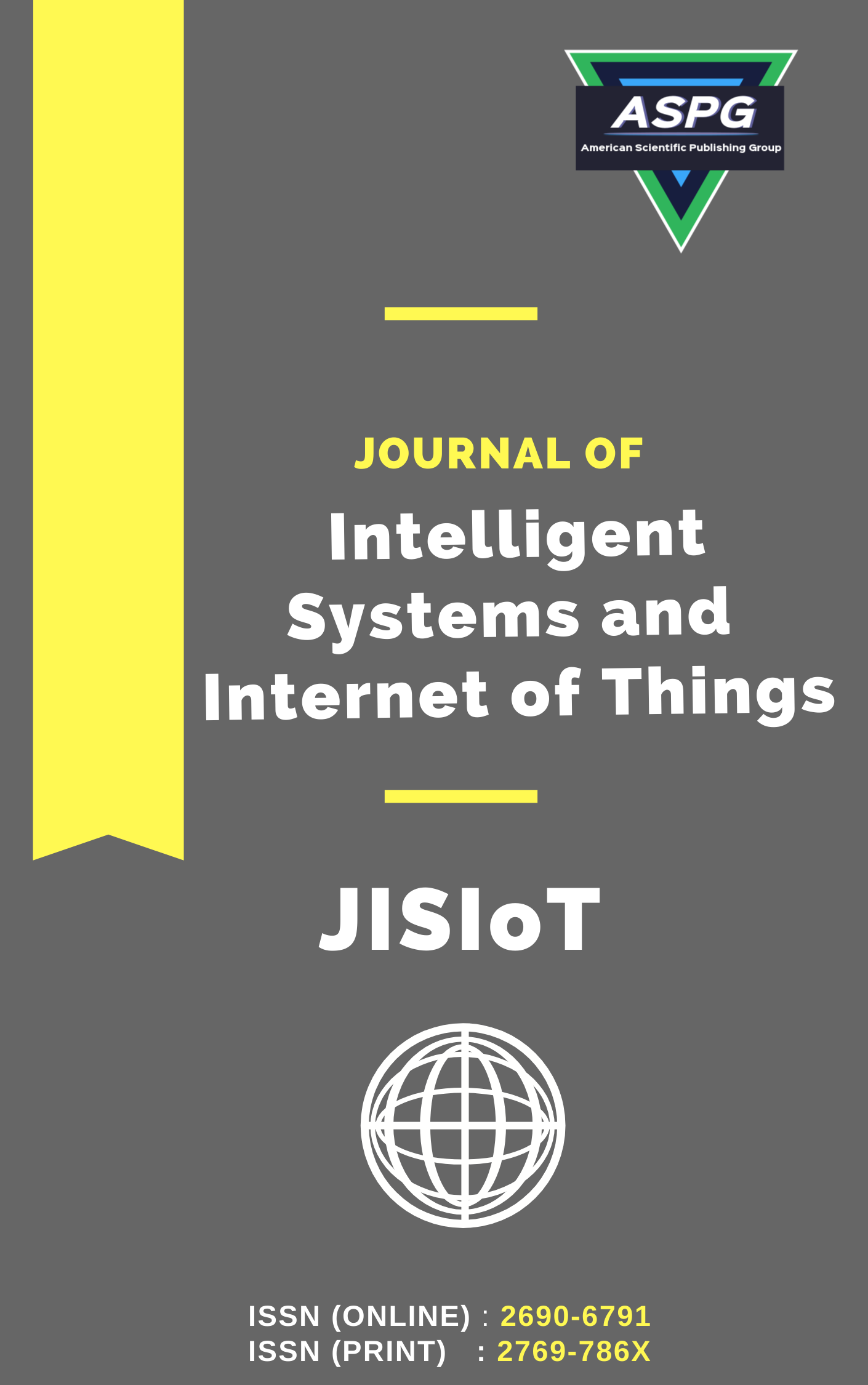

Volume 16 , Issue 2 , PP: 202-213, 2025 | Cite this article as | XML | Html | PDF | Full Length Article
Raghad K. Mohammed 1 , Mohammed Q. Jawad 2 , Othman Mohammed Jasim 3 *
Doi: https://doi.org/10.54216/JISIoT.160215
This study proposes a deep learning-based framework to detect and classify Alzheimer's disease (AD) in the early stages using medical imaging, and specifically Magnetic Resonance Imaging (MRI). Specifically, we propose a Convolution Neural Network (CNN) based model and transfer learn (MobileNet) through pre-trained models based on task domain to improve model performance on binary AD classification. Thanks to minimizing computational complexity and memory costs, the model with 99.86% accuracy rate can mitigate overfitting and is an ideal approach for real time and eco-friendly monitoring of AD evolution. The findings suggest that the model could help clinicians in diagnosing AD even based on MRI images, which has great potential as a scalable and efficient solution for the early-stage diagnosis and classification of the disease. Our work will include the addition of further pre-trained models, increased dataset size via data augmentation, and the application of MRI segmentation to better isolate some of the key features of Alzheimer.
Deep learning , Machine Learning , Alzheimer Detection , MobileNet , Convolution Neural Network
[1] P. T. Kamatham, R. Shukla, D. K. Khatri, and L. K. Vora, “Pathogenesis, diagnostics, and therapeutics for Alzheimer’s disease: Breaking the memory barrier,” Ageing Research Reviews, vol. 101, no. June, p. 102481, 2024, doi: 10.1016/j.arr.2024.102481.
[2] V. Rajinikanth, S. Yassine, and S. A. Bukhari, “Hand-Sketchs based Parkinson’s disease screening using lightweight deep-learning with two-fold training and fused optimal features,” International Journal of Mathematics, Statistics, and Computer Science, vol. 2, pp. 9–18, 2024, doi: 10.59543/ijmscs.v2i.7821.
[3] Z. Breijyeh and R. Karaman, “Comprehensive review on Alzheimer’s disease: Causes and treatment,” Molecules, vol. 25, no. 24, 2020, doi: 10.3390/MOLECULES25245789.
[4] M. Pais et al., “Early diagnosis and treatment of Alzheimer’s disease: New definitions and challenges,” Brazilian Journal of Psychiatry, vol. 42, no. 4, pp. 431–441, 2020, doi: 10.1590/1516-4446-2019-0735.
[5] P. Alzola et al., “Neuropsychological assessment for early detection and diagnosis of dementia: Current knowledge and new insights,” Journal of Clinical Medicine, vol. 13, no. 12, 2024, doi: 10.3390/jcm13123442.
[6] M. Yousif, B. Al-Khateeb, and B. Garcia-Zapirain, “A new quantum circuits of quantum convolutional neural network for X-ray images classification,” IEEE Access, vol. 12, no. May, 2024, doi: 10.1109/ACCESS.2024.3396411.
[7] J. Zhang et al., “Recent advances in Alzheimer’s disease: Mechanisms, clinical trials and new drug development strategies,” Signal Transduction and Targeted Therapy, vol. 9, no. 1, 2024, doi: 10.1038/s41392-024-01911-3.
[8] R. F. Sabri and N. A. Z. Abdullah, “A review for Arabic extremism detection using machine learning,” Iraqi Journal of Science, vol. 65, no. 11, pp. 6617–6630, 2024, doi: 10.24996/ijs.2024.65.11.35.
[9] M. Yousif and B. Al-Khateeb, “Quantum deep learning: A review,” Iraqi Journal of Science, vol. 65, no. 8, pp. 4588–4605, 2024, doi: 10.24996/ijs.2024.65.8.37.
[10] S. Alshattnawi and H. R. Alshboul, “Combined deep learning approaches for intrusion detection systems,” International Journal of Interactive Mobile Technologies, vol. 18, no. 19, pp. 144–155, 2024, doi: 10.3991/ijim.v18i19.49907.
[11] M. Yousif et al., “Enhanced EEG signal classification using machine learning and optimization algorithm,” Fusion: Practice and Applications, vol. 17, no. 2, pp. 211–218, 2025, doi: 10.54216/FPA.170216.
[12] M. Yousif and B. Al-Khateeb, “Quantum convolutional neural network for image classification,” Fusion: Practice and Applications, vol. 15, no. 2, pp. 61–72, 2024, doi: 10.54216/FPA.150205.
[13] T. H. Abd-alamir and M. S. Hathal, “Robust pedestrian detection and tracking using CNN and SORT algorithms,” Iraqi Journal of Science, vol. 66, no. 2, pp. 844–859, 2025, doi: 10.24996/ijs.2025.66.2.23.
[14] R. H. Ali and W. H. Abdulsalam, “Attention-deficit hyperactivity disorder prediction by artificial intelligence techniques,” Iraqi Journal of Science, vol. 65, no. 9, pp. 5281–5294, 2024, doi: 10.24996/ijs.2024.65.9.39.
[15] A. M. Yousif et al., “Melanoma skin cancer detection using deep learning methods and binary GWO algorithm,” Fusion: Practice and Applications, vol. 18, no. 2, pp. 211–220, 2025, doi: 10.54216/FPA.180211.
[16] D. A. Abduljabbar, “Parallel particle swarm optimization algorithm for identifying complex communities in biological networks,” Iraqi Journal of Science, vol. 65, no. 1, pp. 512–527, 2024, doi: 10.24996/ijs.2024.65.1.40.
[17] N. Salih et al., “An advanced approach for predicting ROP stages: Deep learning algorithms and belief function technique,” Iraqi Journal of Science, vol. 65, no. 7, pp. 4047–4060, 2024, doi: 10.24996/ijs.2024.65.7.39.
[18] Y. Huang and A. C. S. Chung, “Disease prediction with edge-variational graph convolutional networks,” Medical Image Analysis, vol. 77, p. 102375, 2022, doi: 10.1016/j.media.2022.102375.
[19] L. Pinto-Coelho, “A survey of innovations and applications,” Bioengineering, vol. 10, no. 12, 2023.
[20] N. M. AbdelAziz et al., “Advanced interpretable diagnosis of Alzheimer’s disease using SECNN-RF framework with explainable AI,” Frontiers in Artificial Intelligence, vol. 7, 2024, doi: 10.3389/frai.2024.1456069.
[21] E. Alickovic and A. Subasi, “Automatic detection of Alzheimer disease based on histogram and random forest,” in CMBEBIH 2019, A. Badnjevic, R. Škrbić, and L. Gurbeta Pokvić, Eds. Cham: Springer, 2020, pp. 91–96.
[22] R. Cui and M. Liu, “RNN-based longitudinal analysis for diagnosis of Alzheimer’s disease,” Computerized Medical Imaging and Graphics, vol. 73, pp. 1–10, 2019, doi: 10.1016/j.compmedimag.2019.01.005.
[23] B. Şener, K. Acici, and E. Sümer, “Categorization of Alzheimer’s disease stages using deep learning approaches with McNemar’s test,” PeerJ Computer Science, vol. 10, p. e1877, 2024, doi: 10.7717/peerj-cs.1877.
[24] N. Hassan, A. S. Musa Miah, and J. Shin, “Residual-based multi-stage deep learning framework for computer-aided Alzheimer’s disease detection,” Journal of Imaging, vol. 10, no. 6, 2024, doi: 10.3390/jimaging10060141.
[25] S. Naganandhini and P. Shanmugavadivu, “Alzheimer’s disease detection in MRI images using deep convolutional neural network model,” EAI Endorsed Transactions on Pervasive Health Technologies, vol. 10, 2024, doi: 10.4108/eetpht.10.6435.
[26] P. Balaji et al., “Hybridized deep learning approach for detecting Alzheimer’s disease,” Biomedicines, vol. 11, no. 1, 2023, doi: 10.3390/biomedicines11010149.